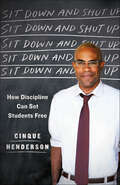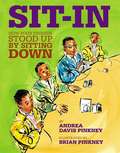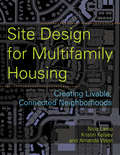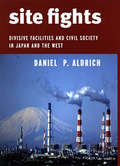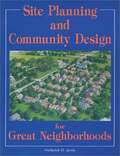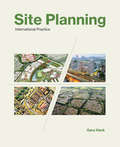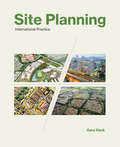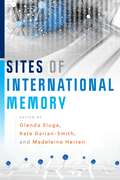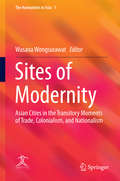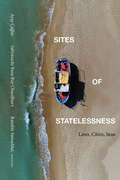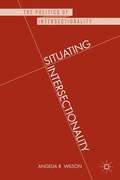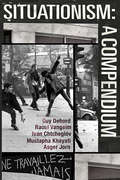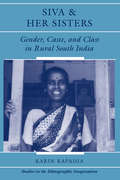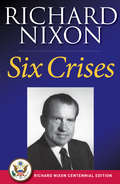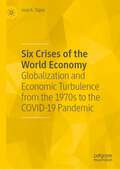- Table View
- List View
Sisters of the War: Two Remarkable True Stories of Survival and Hope in Syria (Scholastic Focus)
by Rania AbouzeidSince the revolution-turned-civil war in Syria began in 2011, over 500,000 civilians have been killed and more than 12 million Syrians have been displaced. Rania Abouzeid, one of the foremost journalists on the topic, follows two pairs of sisters from opposite sides of the conflict to give readers a firsthand glimpse of the turmoil and devastation this strife has wrought. Sunni Muslim Ruha and her younger sister Alaa withstand constant attacks by the Syrian government in rebel-held territory. Alawite sisters Hanin and Jawa try to carry on as normal in the police state of regime-held Syria. The girls grow up in a world where nightly bombings are routine and shrapnel counts as toys. They bear witness to arrests, killings, demolished homes, and further atrocities most adults could not imagine. Still, war does not dampen their sense of hope.Through the stories of Ruha and Alaa and Hanin and Jawa, Abouzeid presents a clear-eyed and page-turning account of the complex conditions in Syria leading to the onset of the harrowing conflict. With Abouzeid's careful attention and remarkable reporting, she crafts an incredibly empathetic and nuanced narrative of the Syrian civil war, and the promise of progress these young people still embody.
Sit Down and Shut Up: How Discipline Can Set Students Free
by Cinque HendersonOn his very first day of school as a substitute teacher, Cinque Henderson was cursed at and openly threatened by one of his students. Not wanting trouble or any broken bones, Henderson called the hall monitor, who escorted the student to the office. But five minutes later the office sent him back with a note that read, “Ok to return to class.” That was it: no suspension, no detention, no phone call home, nothing. Sit Down and Shut Up: How Discipline Can Set Students Free is a passionate and personal analysis of Henderson's year as substitute teacher in some of America’s toughest schools. Students disrespected, yelled at, and threatened teachers, abetted by a school system and political culture that turned a willfully blind eye to the economic and social decline that created the problem. Henderson concludes that the failures of our worst schools are the result of a population in crisis: classrooms are microcosms of all our nation’s most vexing issues of race and class. The legacy and stain of race—the price of generational trauma, the cost of fatherlessness, the failures of capitalism, the false promise of meritocracy—played itself out in every single interaction Henderson had with an aggressive student, an unengaged parent, or a failed administrator. In response to the chaos he found in the classroom, Henderson proposes a recommitment to the notion that discipline—wisely and properly understood, patiently and justly administered—is the only proper route to freedom and opportunity for generations of poor youth. With applications far beyond the classroom, Henderson’s experiences offer novel insights into the pressing racial, social, and economic issues that have shaped America’s cultural landscape.Sure to ignite discussion and controversy, Sit Down and Shut Up provides a frank evaluation of the broken classrooms of America and offers a bold strategy for fixing them.
Sit-In: How Four Friends Stood Up By Sitting Down
by Andrea Davis PinkneyIt was February 1, 1960. They didn't need menus. Their order was simple. A doughnut and coffee, with cream on the side. Courageously defying the WHITES ONLY edict of the area, four young black men took a stand against the injustice of segregation in America by sitting down at the lunch counter of a Woolworth's department store. Countless others of all races soon joined the cause following Martin Luther King Jr.'s powerful words of peaceful protest. By sitting down together, they stood up for civil rights and created the perfect recipe for integration not only at the Woolworth's counter, but on buses and in communities throughout the South.
Site Design for Multifamily Housing: Creating Livable, Connected Neighborhoods
by Nico Larco Kristin Kelsey Amanda WestThe United States is over eighty percent urbanized, yet over half of the population still lives in suburban settings, characterized by low-density, automobile-dependent development with separated land uses. These disconnected and isolated models of development have been linked to increased greenhouse-gas emissions and reduced quality of life, health, and social connections. In Site Design for Multifamily Housing: Creating Livable, Connected Neighborhoods, the authorsexplain that creating more livable and vital communities is within reach and the design and development of multifamily housing is a key component to reaching this goal. Multifamily housing is an important component of increasing density, but large lot multifamily developments often lack connectivity and hence limit livability and walkability. Multifamily housing in suburban areas presents greater challenges than in urban areas due in part to larger lot sizes and street patterns that are often a mix of cul-de-sac, curved, looped, and dead-end streets. Increasing the livability of these developments is an important first step in affecting the livability of the country as a whole. This handbook introduces planners, developers, and designers to ten key elements of multifamily site design, comparing typical and recommended conditions. Case studies of successful large lot multifamily developments as well as retrofit proposals for existing developments with low internal and external connectivity will demonstrate how the tools in the book can be applied. Examples are drawn from Oregon, California, North Carolina, and Arizona. The ideas and tools in this book, including theplanning checklist, code guide, and code summaries, will help users to create more livable, vibrant, and healthy communities.
Site Fights: Divisive Facilities and Civil Society in Japan and the West
by Daniel P. AldrichOne of the most vexing problems for governments is building controversial facilities that serve the needs of all citizens but have adverse consequences for host communities. Policymakers must decide not only where to locate often unwanted projects but also what methods to use when interacting with opposition groups. In Site Fights, Daniel P. Aldrich gathers quantitative evidence from close to five hundred municipalities across Japan to show that planners deliberately seek out acquiescent and unorganized communities for such facilities in order to minimize conflict. When protests arise over nuclear power plants, dams, and airports, agencies regularly rely on the coercive powers of the modern state, such as land expropriation and police repression. Only under pressure from civil society do policymakers move toward financial incentives and public relations campaigns. Through fieldwork and interviews with bureaucrats and activists, Aldrich illustrates these dynamics with case studies from Japan, France, and the United States. The incidents highlighted in Site Fights stress the importance of developing engaged civil society even in the absence of crisis, thereby making communities both less attractive to planners of controversial projects and more effective at resisting future threats.
Site Matters: Strategies for Uncertainty Through Planning and Design
by Andrea Kahn Carol J. BurnsIn the era of the Anthropocene, site matters are more pressing than ever. Building on the concepts, theories, and multi-disciplinary approaches raised in the first edition, this publication strives to address the changes that have taken place over the last 15 years with new material to complement and re-position the initial volume. Reaching across design disciplines, this highly illustrated anthology assembles essays from architects, landscape architects, urban designers, planners, historians, and artists to explore ways to physically and conceptually engage site. Thoughtful discourse and empirically grounded pieces combine to provide the language and theory to contextualize the meanings of site in the built environment. The increasingly complex hybridity of constructed environments today demands new tools for thinking about and working with site. Drawing contributions from outside and within the traditional design disciplines, this edition will trace important developments in site thinking with new essays on topics such as climate change, landscape as infrastructure, shifts from global to planetary urbanization debates, and the proliferation of participatory site transformation practices. Edited by two leading practitioners and academics, Site Matters juxtaposes timeless contributions from individuals including Elizabeth Meyer, Robert Beauregard, and Robin Dripps with original new writings from Peter Marcuse, Jane Wolff, Neil Brenner, and Thaisa Way, amongst others, to recontextualize and reignite the debate around site. An ideal text for students, academics, and researchers interested in site and design theory.
Site Planning and Community Design for Great Neighborhoods
by Frederick D. JarvisSite Planning and Community Design for Great Neighborhoods
Site Planning, Volume 1: International Practice (The\mit Press Ser. #1)
by Gary HackEbook Volume 1 of 3. A comprehensive, state-of-the-art guide to site planning, covering planning processes, new technologies, and sustainability, with extensive treatment of practices in rapidly urbanizing countries.Ebook Volume 1 of 3.Cities are built site by site. Site planning—the art and science of designing settlements on the land—encompasses a range of activities undertaken by architects, planners, urban designers, landscape architects, and engineers. This book offers a comprehensive, up-to-date guide to site planning that is global in scope. It covers planning processes and standards, new technologies, sustainability, and cultural context, addressing the roles of all participants and stakeholders and offering extensive treatment of practices in rapidly urbanizing countries. Kevin Lynch and Gary Hack wrote the classic text on the subject, and this book takes up where the earlier book left off. It can be used as a textbook and will be an essential reference for practitioners.Site Planning consists of forty self-contained modules, organized into five parts: The Art of Site Planning, which presents site planning as a shared enterprise; Understanding Sites, covering the components of site analysis; Planning Sites, covering the processes involved; Site Infrastructure, from transit to waste systems; and Site Prototypes, including housing, recreation, and mixed use. Each module offers a brief introduction, covers standards or approaches, provides examples, and presents innovative practices in sidebars. The book is lavishly illustrated with 1350 photographs, diagrams, and examples of practice.
Site Planning, Volume 2: International Practice (The\mit Press Ser. #2)
by Gary HackEbook Volume 2 of 3. A comprehensive, state-of-the-art guide to site planning, covering planning processes, new technologies, and sustainability, with extensive treatment of practices in rapidly urbanizing countries.Ebook Volume 2 of 3.Cities are built site by site. Site planning—the art and science of designing settlements on the land—encompasses a range of activities undertaken by architects, planners, urban designers, landscape architects, and engineers. This book offers a comprehensive, up-to-date guide to site planning that is global in scope. It covers planning processes and standards, new technologies, sustainability, and cultural context, addressing the roles of all participants and stakeholders and offering extensive treatment of practices in rapidly urbanizing countries. Kevin Lynch and Gary Hack wrote the classic text on the subject, and this book takes up where the earlier book left off. It can be used as a textbook and will be an essential reference for practitioners.Site Planning consists of forty self-contained modules, organized into five parts: The Art of Site Planning, which presents site planning as a shared enterprise; Understanding Sites, covering the components of site analysis; Planning Sites, covering the processes involved; Site Infrastructure, from transit to waste systems; and Site Prototypes, including housing, recreation, and mixed use. Each module offers a brief introduction, covers standards or approaches, provides examples, and presents innovative practices in sidebars. The book is lavishly illustrated with 1350 photographs, diagrams, and examples of practice.
Site Planning, Volume 3: International Practice (The\mit Press Ser. #3)
by Gary HackEbook Volume 3 of 3. A comprehensive, state-of-the-art guide to site planning, covering planning processes, new technologies, and sustainability, with extensive treatment of practices in rapidly urbanizing countries.Ebook Volume 3 of 3.Cities are built site by site. Site planning—the art and science of designing settlements on the land—encompasses a range of activities undertaken by architects, planners, urban designers, landscape architects, and engineers. This book offers a comprehensive, up-to-date guide to site planning that is global in scope. It covers planning processes and standards, new technologies, sustainability, and cultural context, addressing the roles of all participants and stakeholders and offering extensive treatment of practices in rapidly urbanizing countries. Kevin Lynch and Gary Hack wrote the classic text on the subject, and this book takes up where the earlier book left off. It can be used as a textbook and will be an essential reference for practitioners.Site Planning consists of forty self-contained modules, organized into five parts: The Art of Site Planning, which presents site planning as a shared enterprise; Understanding Sites, covering the components of site analysis; Planning Sites, covering the processes involved; Site Infrastructure, from transit to waste systems; and Site Prototypes, including housing, recreation, and mixed use. Each module offers a brief introduction, covers standards or approaches, provides examples, and presents innovative practices in sidebars. The book is lavishly illustrated with 1350 photographs, diagrams, and examples of practice.
Sites of Genocide
by Adam Jones"Genocide" may be the most powerful word in the English language. What is the significance and relevance of this formative concept today? In an extraordinarily wide-ranging collection of essays and interviews, Adam Jones, one of the world's leading genocide scholars, explores the uses and controversies surrounding the term that Raphael Lemkin coined during the Second World War to describe and prohibit mass atrocities against defined human groups. In a style that is learned but always accessible and engaging, Jones addresses key historical and contemporary issues, such as: What were the motivations and proclaimed justifications for genocide in the "long nineteenth century" that shaped our modern world? How can "humanitarian" interventions in genocide avoid sliding into new imperialism? What are the connections between religion and genocide? How can the gender variable in genocide perpetration and victimization be understood? A wide range of historical and contemporary genocides and crimes against humanity, from the eighteenth-century slave rebellion in Haiti to Myanmar's destruction of the Rohingya, and to the forms of structural and systemic violence that Jones argues should be encompassed by any global-historical understanding of genocide. Sites of Genocide is illustrated with photos from Jones's own collection and other sources. It will be of interest to all students and scholars of human rights and for general readers seeking a point of entry to the rich and provocative debates in comparative genocide studies.
Sites of Governance
by Martin Horak Robert YoungPolicies forged by all levels of government affect the lives of urban residents. Contributors to this volume explore how intergovernmental relations shape urban policies and how various social forces are involved in - or excluded from - the policy process. Focusing on diverse policy fields including emergency planning, image-building, immigrant settlement, infrastructure, federal property, and urban Aboriginal policy, Sites of Governance presents detailed studies of the largest city in each of Canada's provinces. Drawing on extensive documentary research and hundreds of interviews, contributors offer rich, nuanced analyses and a wealth of policy cases, ranging from preparation for the Vancouver 2010 Olympics to the development of innovative immigrant settlement programming in Winnipeg. Dominant themes include the importance of resources and formal jurisdiction in multilevel policy making, and the struggle for influence between business interests and other social forces. Essential reading for anyone concerned with the quality of urban life in Canada, Sites of Governance offers important insights about how multilevel governance works in Canadian cities. Contributors include Laurence Bherer (Université de Montréal), David Bulger (University of Prince Edward Island), Christopher Dunn (Memorial University), Robert Finbow (Dalhousie University), Joseph Garcea (University of Saskatchewan), Pierre Hamel (Université de Montréal), Martin Horak (University of Western Ontario), Thomas Hutton (University of British Columbia), Christopher Leo (University of Winnipeg), Greg Marquis (University of New Brunswick , Saint John), Byron Miller (University of Calgary), Cecily Pantin (Memorial University), Alan Smart (University of Calgary), Donald Story (University of Saskatchewan), and Robert Young (University of Western Ontario).
Sites of Governance: Multilevel Governance and Policy Making in Canada's Big Cities (Fields of Governance: Policy Making in Canadian Municipalities)
by Martin Horak Robert YoungPolicies forged by all levels of government affect the lives of urban residents. Contributors to this volume explore how intergovernmental relations shape urban policies and how various social forces are involved in - or excluded from - the policy process. Focusing on diverse policy fields including emergency planning, image-building, immigrant settlement, infrastructure, federal property, and urban Aboriginal policy, Sites of Governance presents detailed studies of the largest city in each of Canada's provinces. Drawing on extensive documentary research and hundreds of interviews, contributors offer rich, nuanced analyses and a wealth of policy cases, ranging from preparation for the Vancouver 2010 Olympics to the development of innovative immigrant settlement programming in Winnipeg. Dominant themes include the importance of resources and formal jurisdiction in multilevel policy making, and the struggle for influence between business interests and other social forces. Essential reading for anyone concerned with the quality of urban life in Canada, Sites of Governance offers important insights about how multilevel governance works in Canadian cities. Contributors include Laurence Bherer (Université de Montréal), David Bulger (University of Prince Edward Island), Christopher Dunn (Memorial University), Robert Finbow (Dalhousie University), Joseph Garcea (University of Saskatchewan), Pierre Hamel (Université de Montréal), Martin Horak (University of Western Ontario), Thomas Hutton (University of British Columbia), Christopher Leo (University of Winnipeg), Greg Marquis (University of New Brunswick , Saint John), Byron Miller (University of Calgary), Cecily Pantin (Memorial University), Alan Smart (University of Calgary), Donald Story (University of Saskatchewan), and Robert Young (University of Western Ontario).
Sites of International Memory
by Glenda Sluga, Kate Darian-Smith, and Madeleine HerrenWhether we think of statues, plaques, street-names, practices, material or intangible forms of remembrance, the language of collective memory is everywhere, installed in the name of not only nations, or even empires, but also an international past. The essays in Sites of International Memory address the notion of a shared past, and how this idea is promulgated through sites and commemorative gestures that create or promote cultural memory of such global issues as wars, genocide, and movements of cross-national trade and commerce, as well as resistance and revolution.In doing so, this edited collection asks: Where are the sites of international memory? What are the elements of such memories of international pasts, and of internationalism? How and why have we remembered or forgotten “sites” of international memory? Which elements of these international pasts are useful in the present?Some contributors address specific sites and moments—World War II, liberation movements in India and Ethiopia, commemorations of genocide—while other pieces concentrate more on the theoretical, on the idea of cultural memory. UNESCO’s presence looms large in the volume, as it is the most visible and iconic international organization devoted to creating critical heritage studies on a world stage. Formed in the aftermath of World War II, UNESCO was instrumental in promoting the idea of a “humanity” that exists beyond national, regional, or cultural borders or definitions. Since then, UNESCO’s diplomatic and institutional channels have become the sites at which competing notions of international, world, and “human” communities have jostled in conjunction with politically specific understandings of cultural value and human rights.This volume has been assembled to investigate sites of international memory that commemorate a past when it was possible to imagine, identify, and invoke “international” ideas, institutions, and experiences, in diverse, historically situated contexts.Contributors:Dominique Biehl, Kristal Buckley, Roland Burke, Kate Darian-Smith, Sarah C. Dunstan, David Goodman, Madeleine Herren, Philippa Hetherington, Rohan Howitt, Alanna O’Malley, Eric Paglia, Glenda Sluga, Sverker Sörlin, Carolien Stolte, Beatrice Wayne, Ralph Weber, Jay Winter.
Sites of Modernity
by Wasana WongsurawatThis book investigates, compares and contrasts the experience of entering into and engaging in modernity and the modern era in many parts of the Asian continent. It focuses on the coming into being, development, and transformation of major urban centers from Tokyo to Mumbai from the late 19th century to the present, providing a broad overview of this crucial period of transition in Asia, not only from diverse geographical and historical perspectives, but also incorporating a broad range of further disciplines.
Sites of Modernity—Places of Risk: Risk and Security in Germany since the 1970s (New German Historical Perspectives #12)
by Martin H. Geyer“Places of risk” and “sites of modernity” refer not merely to physical locations, but also objects and institutions that stand at the center of contemporary debates on security and risk. These are social and political domains where energy and infrastructure are produced, where domestic security is pursued and maintained, and where citizens encounter the state in its punitive or monitory roles. Taking a wide view of the period from the 1970s to today, this volume brings together innovative, interdisciplinary case studies of sites of modernity that promise to provide security and safety, yet at the same time are deemed responsible for creating new risks. With a particular contemporary interest in the technocratic changes of security and risk control the contributors to Sites of Modernity — Places of Risk position the 1970s as a turning point in the path from industrial to post-industrial modernity.
Sites of Statelessness: Laws, Cities, Seas (SUNY series in Global Modernity)
by Ayşe Çağlar; Sabyasachi Basu Ray Chaudhury; Ranabir SamaddarStatelessness is incessantly produced in seas, cities, and law. Building around the postcolonial experiences of statelessness Sites of Statelessness examines the entanglements of citizenship policies and practices with the spread of statelessness in contemporary times, something that defies any kind of a citizen/stateless binary. These policies are significant, the background of a shift in emphasis from jus soli to jus sanguinis, the proliferation of borderland populations and nowhere people, population flows across (post)colonial border formations and boundary delimitations, and the growth of regional, formal, and informal labor markets characterized by immigrant labor economies. In this context, contributors address the distinctive dynamics of the different sites in the production of statelessness and considers the impact of these sites as critical and does not merely treat them as a backdrop. They argue that these different sites evoke different histories and repertoires and also bring different possibilities of alignment with emerging problematics.
Sitte, Hegemann and the Metropolis: Modern Civic Art and International Exchanges
by Jean-François Lejeune Charles C. BohlThese essays, from leading names in the field, weave together the parallels and differences between the past and present of civic art. Offering prospects for the first decades of the twenty-first century, the authors open up a broad international dialogue on civic art, which relates historical practice to the contemporary meaning of civic art and its application to community building within today’s multi-cultural modern cities. The volume brings together the rich perspectives on the thought, practice and influence of leading figures from the great era of civic art that began in the nineteenth century and blossomed in the early twentieth century as documented in the works of Werner Hegemann and his contemporaries and considered fundamental to contemporary practice.
Situating Intersectionality Politics, Policy, And Power
by Angelia R. WilsonA new generation of political science scholars who are comfortable employing intersectional analysis are emerging and their work hones in directly on the complexity of politics, governance and policy making in an increasingly small, technologically connected, ideologically nuanced, global Public Square.
Situationism: A Compendium
by Guy Debord Ivan Chtcheglov Mustapha Khayati Raoul Vaneigem Asger JornAfter Guy Debord's seminal Society of the Spectacle, this new compendium brings together eight other important situationist works. Ivan Chtcheglov opens proceedings via his Formulary for a New Urbanism (1953), with it's quasi-mythical demand that resonated down through generations: "The hacienda must be built", followed by two brief but illuminating pieces from Asger Jorn, who's sandpaper book cover later turned up under the same Factory Records roof as Manchesters' own Hacienda, on the Durrtti Column's "Return of the Durrutti Column" ( the title itself lifted from Andre Bertrand's détourned pro-situ comic strip). Debord's The Decline and Fall of the Spectacle-Commodity Economy-was an immediate, razor sharp response to the LA/Watts Riots of 1965, it's analysis of the relationship between the rioter and the meaningless, unaffordable commodities they loot or destroy resonating heavily today. Tunisian situationist Mustapha Khayati contributes Address to Revolutionaries of Algeria and of All Countries and the game changing "On the Poverty of Student Life", the match that arguably lit the fires of May 68'. Raoul Vaneigem's The Revolution of Everyday Life finishes things off in defiant fashion : ". You're f*%@g Around With Us? -- Not For Long!"
Siva And Her Sisters: Gender, Caste, And Class In Rural South India
by Karin KapadiaA study of the impact of caste and class on conceptions of gender, this book focuses on the lower castes/classes of South India. Examining the lives and work of ‘untouchable’ women in a village in Tamilnadu, the author explores the recently articulated critique of feminism that race, caste, and class may be more important factors than gender in a p
Six Amendments: How and Why We Should Change the Constitution
by John Paul StevensFor the first time ever, a retired Supreme Court Justice offers a manifesto on how the Constitution needs to change. By the time of his retirement in June 2010, John Paul Stevens had become the second longest serving Justice in the history of the Supreme Court. Now he draws upon his more than three decades on the Court, during which he was involved with many of the defining decisions of the modern era, to offer a book like none other. SIX AMENDMENTS is an absolutely unprecedented call to arms, detailing six specific ways in which the Constitution should be amended in order to protect our democracy and the safety and wellbeing of American citizens. Written with the same precision and elegance that made Stevens's own Court opinions legendary for their clarity as well as logic, SIX AMENDMENTS is a remarkable work, both because of its unprecedented nature and, in an age of partisan ferocity, its inarguable common sense.
Six Angry Girls
by Adrienne KisnerAdrienne Kisner's Six Angry Girls is a story of mock trial, feminism, and the inherent power found in a pair of knitting needles. Raina Petree is crushing her senior year, until her boyfriend dumps her, the drama club (basically) dumps her, the college of her dreams slips away, and her arch-nemesis triumphs. Things aren’t much better for Millie Goodwin. Her father treats her like a servant, and the all-boy Mock Trial team votes her out, even after she spent the last three years helping to build its success.But then, an advice columnist unexpectedly helps Raina find new purpose in a pair of knitting needles and a politically active local yarn store. This leads to an unlikely meeting in the girls’ bathroom, where Raina inspires Millie to start a rival team. The two join together and recruit four other angry girls to not only take on Mock Trial, but to smash the patriarchy in the process.
Six Crises
by Richard NixonFor many years before he became President, Richard Nixon's decisions vitally affected the well-being of the nation. Six of those decisions significantly shaped the man who would later become the 37th President of the United States. Six Crises is a close-up look at this dynamic man, recalling the demands placed upon him, the thinking behind his decisions, and the pressures of political life.
Six Crises of the World Economy: Globalization and Economic Turbulence from the 1970s to the COVID-19 Pandemic
by José A. TapiaThis book is about the crises of the world economy that have occurred from the 1970s to the present day. It makes the specific case that the global economy has experienced six crises during this 50-year period. Crises of the global economy are periods of substantial slowdown in world economic activity—as measured by investment, industrial production, trade, or unemployment—in which many national economies are technically in recession. To pose the existence of crises of the global economy implies that the world economy is a real entity with its own dynamics; it implies also that the usual approach that views national economies as the appropriate units of economic analysis has major limitations. The author provides data illustrating the global and regional manifestations of these crises of the world economy, elaborates on the concepts of world economy and economic crisis, and discusses the theories that have been used to explain them. The book shows how these recurrent global crises are discrete, countable phenomena, distinct states of an entity that can be appropriately referred to as the world or global economy, or world capitalism.

